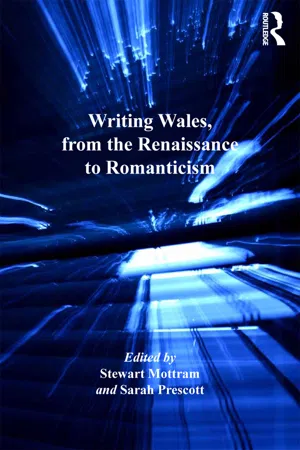
Writing Wales, from the Renaissance to Romanticism
- 248 pages
- English
- ePUB (mobile friendly)
- Available on iOS & Android
Writing Wales, from the Renaissance to Romanticism
About This Book
Writing Wales explores representations of Wales in English and Welsh literatures written across a broad sweep of history, from the union of Wales with England in 1536 to the beginnings of its industrialization at the turn of the nineteenth century. The collection offers a timely contribution to the current devolutionary energies that are transforming the study of British literatures today, and it builds on recent work on Wales in Renaissance, eighteenth-century, and Romantic literary studies. What is unique about Writing Wales is that it cuts across these period divisions to enable readers for the first time to chart the development of literary treatments of Wales across three of the most tumultuous centuries in the history of British state-formation. Writing Wales explores how these period divisions have helped shape scholarly treatments of Wales, and it asks if we should continue to reinforce such period divisions, or else reconfigure our approach to Wales' literary past. The essays collected here reflect the full 300-year time span of the volume and explore writers canonical and non-canonical alike: George Peele, Michael Drayton, Henry Vaughan, Katherine Philips, and John Dyer here feature alongside other lesser-known authors. The collection showcases the wide variety of literary representations of Wales, and it explores relationships between the perception of Wales in literature and the realities of its role on the British political stage.
Frequently asked questions
Information
PART I Renaissance to Seventeenth Century
1 Early Modern Welsh Nationalism and the British History
Table of contents
- Cover
- Halftitle Page
- Title Page
- Copyright Page
- Contents
- List of Figures
- Notes on Contributors
- Acknowledgements
- Introduction
- Part 1 Renaissance to Seventeenth Century
- 1 Early Modern Welsh Nationalism and the British History
- 2 Writing on Borderlines: Anglo-Welsh Relations in Thomas Churchyard’s The Worthines of Wales
- 3 Green Tights and Swordfights: Edward I and the Making of Memories
- 4 ‘Prince of Wales by Cambria’s Full Consent’?: The Princedom of Wales and the Early Modern Stage
- 5 William Browne and the Writing of Early Stuart Wales
- Part 2 Seventeenth Century to Romanticism
- 6 Morgan Llwyd and the Foundations of the ‘Nonconformist Nation’
- 7 ‘If there be Helicon in Wales it is’: Writing Wales in Seventeenth- and Eighteenth-Century Poetry
- 8 ‘No rebellious jarring noise’: Expressions of Loyalty to the British State in Eighteenth-Century Welsh Writing
- 9 ‘Walking Conundrums’: Masquerades, Riddles, and National Identity in Late Eighteenth-Century Wales
- 10 Haunted by History: Welsh Gothic 1780–1800 183
- Bibliography
- Index